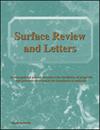研究了镀液温度对无稳定剂镀液制备的Ni-B-Mo化学镀层结构和摩擦学性能的影响
IF 1.2
4区 材料科学
Q4 CHEMISTRY, PHYSICAL
引用次数: 0
摘要
传统的化学镀Ni-B-Mo (ENB-Mo)沉积物是使用有害的含铅或含铊溶液形成的,必须将其去除。在本研究中,ENB-Mo矿床是在不含稳定剂和有害重金属的浴液中发育的。研究了镀液温度的变化对在AISI 1040钢上制备的ENB-Mo涂层摩擦学性能的影响。选择的浴温为85[公式:见文]℃,90[公式:见文]℃,95[公式:见文]℃,以获得不同B和Mo含量的ENB-Mo涂层。12-15 m厚的涂层均匀。与钢基体相比,所有涂层都表现出增强的耐腐蚀性。在沉积状态下,涂层为非晶与纳米晶混合,Fe峰与Ni峰重叠。此外,TGA结果表明钼的加入增强了涂层的热稳定性。300℃时的磨损试样[公式:见文]C显示了屏蔽氧化摩擦涂层的发展和微观组织的变化。在高工作温度下(300℃[公式:见文]C),磨损碎屑对涂层的摩擦学机理也有重大影响。研究了ENB-Mo涂层的微观结构、摩擦学性能和耐蚀性之间的关系。本文章由计算机程序翻译,如有差异,请以英文原文为准。
The effect of bath temperature on the structure and tribological behaviour of electroless Ni-B-Mo coatings obtained from stabilizer free bath
Conventional electroless Ni–B–Mo (ENB–Mo) deposits are formed using hazardous lead or thallium-containing solutions, which must be removed. In this study, ENB–Mo deposits were developed in a bath free of stabilizers and harmful heavy metals. This study estimates the effect of variation of coating bath temperature on tribological performance of ENB–Mo coating developed over AISI 1040 steel. The chosen bath temperatures were 85[Formula: see text]C, 90[Formula: see text]C, and 95[Formula: see text]C to achieve ENB–Mo coating with varying B and Mo content. The 12–15 [Formula: see text]m thick coating was uniform. In comparison to steel substrate, all of the coatings show enhanced corrosion resistance. In the as-deposited state, coatings were mixed amorphous and nanocrystalline with peak of Fe overlapping with Ni. Moreover, TGA results revealed that inclusion of molybdenum enhanced coatings thermal stability. The worn specimens at 300[Formula: see text]C reveal development of shielding tribo-oxide coatings and existence of microstructural changes. At high working temperatures (300[Formula: see text]C), wear debris also has a major impact on tribological mechanisms of coatings. Correlation between microstructure, tribological behavior, and corrosion resistance have also been conducted for ENB–Mo coatings.
求助全文
通过发布文献求助,成功后即可免费获取论文全文。
去求助
来源期刊

Surface Review and Letters
工程技术-物理:凝聚态物理
CiteScore
2.20
自引率
9.10%
发文量
139
审稿时长
4.2 months
期刊介绍:
This international journal is devoted to the elucidation of properties and processes that occur at the boundaries of materials. The scope of the journal covers a broad range of topics in experimental and theoretical studies of surfaces and interfaces. Both the physical and chemical properties are covered. The journal also places emphasis on emerging areas of cross-disciplinary research where new phenomena occur due to the presence of a surface or an interface. Representative areas include surface and interface structures; their electronic, magnetic and optical properties; dynamics and energetics; chemical reactions at surfaces; phase transitions, reconstruction, roughening and melting; defects, nucleation and growth; and new surface and interface characterization techniques.
 求助内容:
求助内容: 应助结果提醒方式:
应助结果提醒方式:


